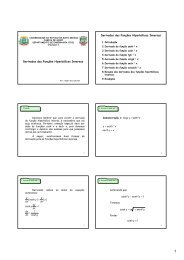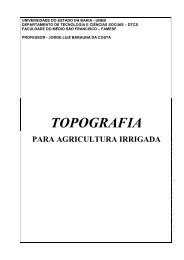Anuário Brasileiro do Arroz 2011 - Unemat
Anuário Brasileiro do Arroz 2011 - Unemat
Anuário Brasileiro do Arroz 2011 - Unemat
You also want an ePaper? Increase the reach of your titles
YUMPU automatically turns print PDFs into web optimized ePapers that Google loves.
For almost five<br />
centuries, red rice<br />
has been planted<br />
and consumed<br />
in Brazil’s<br />
Northeastern<br />
regional cooking,<br />
but is threatened<br />
with extinction<br />
Red is<br />
good<br />
Staple food of slaves in colonial<br />
times, red rice in the Northeast, also<br />
known as rice of the land or Venice<br />
Rice, produced in Vale <strong>do</strong> Piancó,<br />
State of Paraíba, is now being rescued<br />
through a process that seeks<br />
the Geographical Indication label<br />
for the cereal now being threatened<br />
with extinction. Among the targets,<br />
the initiative of the growers,<br />
researchers, government and nongovernment<br />
organizations seek to<br />
prevent the genetic material from<br />
being lost, provide food safety to the<br />
hinterland people, create means that<br />
stimulate production and consumption,<br />
give the rice its due and win international<br />
recognition through the<br />
Geographical Indication distinction.<br />
Cultivated over almost five centuries<br />
up to the present as a family<br />
business in the fields of Paraíba,<br />
Pernambuco and Rio Grande <strong>do</strong><br />
Norte, this reddish cereal is a delicacy<br />
in the northeastern cuisine. It<br />
is also found, on a smaller scale,<br />
in Ceará, Bahia, Alagoas and in<br />
the North of Minas Gerais. The<br />
area planted to this cereal in Brazil<br />
reaches some 10 thousand hectares<br />
per season, half of them in Paraíba.<br />
Recently, demand for it has been rising<br />
in restaurants in huge consumer<br />
centers like São Paulo (SP), Rio de<br />
Janeiro (RJ) and Brasília (DF).<br />
“It is a kernel of relevant social<br />
and economic importance”, says<br />
José Almeida Pereira, researcher<br />
with Embrapa Mid-North, in Teresina<br />
(PI). According to him, the cereal<br />
grown in the region is certainly an<br />
ecologically friendly product, since<br />
no agrochemicals have ever been<br />
used. These are subsistence crops,<br />
without any technology, with yields<br />
of 1 ton per hectare. It has nothing<br />
to <strong>do</strong> with the red rice that infests<br />
the fields in the South, where its<br />
mutation is a weed.<br />
DISTINCTION The process<br />
to conquer the Geographical<br />
Indication label for the red rice of<br />
Vale <strong>do</strong> Piacó (PB), which comprises<br />
the municipalities of Santana <strong>do</strong>s<br />
Garrotes, Nova Olinda, Piancó, Olho<br />
D’água, Aguiar, Emas, Catingueira<br />
and Igaracy, is now in its consolidation<br />
phase and seeks, initially,<br />
the Indication of Origin. An agreement<br />
has been signed between the<br />
Ministry of Agriculture, Livestock and<br />
Food Supply (Mapa), the Federation<br />
of Agriculture and Livestock in<br />
Paraíba (Faepa) and the National<br />
Rural Learning Service (Senar-PB) for<br />
executing the process, which is supposed<br />
to be concluded by July <strong>2011</strong>.<br />
During this first half of the year, the<br />
producers are getting acquainted<br />
with the necessary Regulations and<br />
area limitations, under the responsibility<br />
of the Brazilian Institute of<br />
Geography and Statistics (IBGE).<br />
According to Manoel Octávio<br />
Silveira da Mota, one of the coordinators<br />
of the project, “the label<br />
represents the continuity of the crop<br />
in accordance with its origin and<br />
regional characteristics, besides creating<br />
a security network around the<br />
red rice, adding commercial value<br />
to it”. One of the great challenges<br />
of the project is to organize the production<br />
chain and the management<br />
systems.<br />
The collection of germ plasm<br />
samples across the Northeast, North<br />
and part of the Southeast came up<br />
with 26 different varieties. They<br />
give rise to the genetic material<br />
database, which is supposed to be<br />
the source for cultivars of good agronomic<br />
traits and better management<br />
technologies, to be generated<br />
by Embrapa. The corporation runs<br />
observation and experimentation<br />
units in Paraíba to transfer technologies<br />
to the crop. Two breeds were<br />
seeded in Fazenda Mocó, in Souza<br />
(PB) — the MNA PB 0405 and the<br />
MNA CH 0501 for trials, with good<br />
initial results and are poised to become<br />
commercial varieties. In <strong>2011</strong>,<br />
Embrapa Rice and Beans (GO) joined<br />
the project.<br />
57


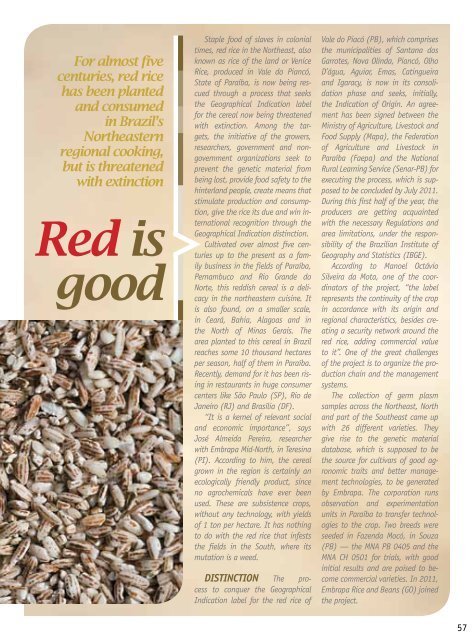
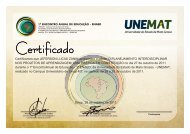
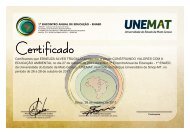
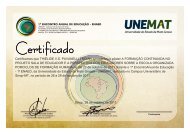
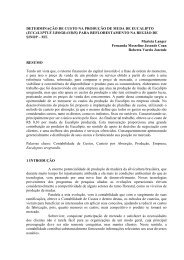
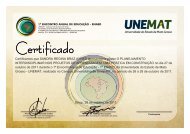
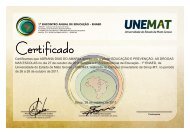
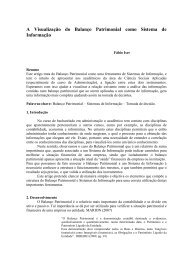
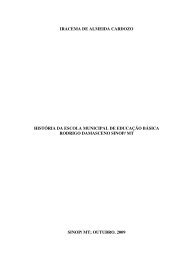

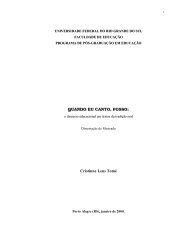
![Aula 31 - Funções Hiperbólicas [Modo de Compatibilidade] - Unemat](https://img.yumpu.com/14334654/1/184x260/aula-31-funcoes-hiperbolicas-modo-de-compatibilidade-unemat.jpg?quality=85)
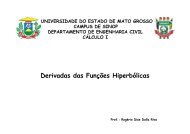
![Aula 31 - Funções Hiperbólicas [Modo de Compatibilidade] - Unemat](https://img.yumpu.com/14332146/1/190x135/aula-31-funcoes-hiperbolicas-modo-de-compatibilidade-unemat.jpg?quality=85)
